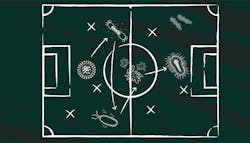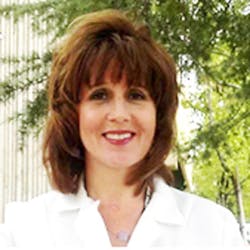In his recent article, Health Care Environmental Hygiene: New Insights and Centers for Disease Control and Prevention Guidance, Philip C. Carling, Department of Infectious Diseases, Boston University School of Medicine, describes how “patient zone environmental hygiene” plays a critical role in “mitigating the transmission of health care-associated pathogens (HAPs).”1
He stresses the importance of implementing “horizontal interventions,” aimed at reducing the “risk of infections caused by a broad range of pathogens by the implementation of standard practices that are effective regardless of patient-specific conditions.”
Let’s look at two of these interventions, hand hygiene and hygienic cleaning, within the scope of the U.S. Centers for Disease Control and Prevention (CDC) 2020 guidance: Core Components of Environmental Cleaning and Disinfection in Hospitals, which Carling cites in his article. Infection preventionists (IP) and suppliers of hygiene products and solutions share their insights on driving compliance and accountability.
Hands as a component of hygiene
A recent survey on hand hygiene practices, conducted by GP PRO, a division of Georgia-Pacific, found just 39% of healthcare workers consistently comply with hand hygiene protocols primarily due to five common barriers: emergencies that require immediate attention; a busy workload; malfunctioning, broken or empty hand sanitizer dispensers; full hands; and difficulty during the glove on and glove off process.2
As Carling notes in his article, “further consideration must be given to viewing both environmental hygiene and hand hygiene as being interdependent interventions.” Because they are “intrinsically relevant,” he refers to the two together as “hygienic practice.”
“I think of hand hygiene as the overarching umbrella theme and under that are electronic monitoring and direct observation,” said Kuhnly. “Direct observation, which is the gold standard, is where I have the most passion. I find motivating a culture of safety is the most important factor to compliance and continued patient safety.”
Kuhnly’s approach is to motivate people to speak up when they see a “missed opportunity” for hand hygiene and give positive reinforcement when proper hygiene is observed. Her team has set a goal of 100 direct observations per unit, per month. To help drive accountability, they send out monthly reports to unit leadership and department managers with both electronic and direct observation data and engage in bi-weekly meetings to target compliance goals.
When a unit falls behind, Kuhnly works with the team to understand barriers and take steps to overcome them.
“We all grow up knowing how to wash our hands but there are so many potential flaws in the technique. For example, if you lathered for 5 seconds instead of the recommended 15 seconds, or don’t fully friction rub hard-to-reach areas, you may not be completing hand-hygiene correctly,” said Kuhnly. “So sometimes it is reiterating the importance of the technique.”
Hygiene focused on the patient
Patient hand hygiene protocols have not been a priority, notes Amanda Thornton, RN, MSN, CIC, VA-BC, Clinical Science Liaison, PDI; however, studies have shown that they can potentially reduce the rate of healthcare acquired infections (HAIs), including Clostridioides difficile (C. diff).4
A study performed in a 495-bed university-affiliated medical center showed that providing bedbound patients with pre-saturated hand hygiene wipes resulted in a statistically significant decrease in the number of C. diff observed hospital onset laboratory identified (LabID) events in the first two quarters after implementation.5
According to Vollman, patient bathing is another nursing activity that often doesn’t follow a standardized protocol. Each hospital, unit, and even the caregiver determines the method in which patients are bathed. She states:
“An easy way to improve hygiene compliance is to standardize the method and products used for patient bathing. Eliminating bath basins and use of tap water and choosing a skin-friendly prepackaged bathing product can help hospitals improve the patient’s bathing experience, potentially decrease the bioburden on the patient’s skin, and ensure that every patient is receiving the same hygiene intervention.”
“Oral care is another simple intervention that can positively impact patient outcomes,” Vollman added. “For independent patients, brushing teeth 2-4 times a day can help address risk factors of infection. For ventilated patients, using sequential specialized systems and kits that are designed to remove plaque, debris and oral secretions can improve compliance and address infection risk. For both skin and oral care, when process variation is decreased, quality may increase.”
Hand hygiene compliance and monitoring
“With the initial COVID-19 crisis behind us, many healthcare facilities are refocusing on basic patient safety metrics such as hand hygiene and are wondering where to start (or re-start),” said Megan DiGiorgio, MSN, RN, CIC, FAPIC, Senior Clinical Manager, GOJO. “It’s easy for hand hygiene leaders to assume that healthcare workers (HCW) know when to perform hand hygiene. But HCW can know conceptually what they need to do and when they need to do it and have difficulty following through with behaviors once inside the context of their busy workday.”
DiGiorgio says periodic hand hygiene education is insufficient to ensure hand hygiene is performed at the right moment, while proximity can have a very powerful impact on behavior in the moment.
“Unit-based programs for norm setting, speaking up and encouraging everyone on the front lines to provide reminders for missed opportunities can help create and sustain a new set of habits and practices,” DiGiorgio explains. “Improving and sustaining hand hygiene performance is work that spans over years, not months, but it’s a worthwhile journey.”
“There are three methods to measure compliance – direct observation, product tracking or electronic hand hygiene monitoring. Each of these methods has advantages and challenges. However, an electronic hand hygiene compliance monitoring system that captures hand hygiene opportunities associated with the patient zone rather than room entry/exit can provide the volume and type of accurate data needed to drive targeted, actionable results and meet Leapfrog requirements.”
Homan says second, select a monitoring method that is accurate. “While direct observation is critical to provide feedback on hand hygiene technique, it is well-known that it is subject to bias due to Hawthorne effect, observer bias, and selection bias,” she commented. “These factors make direct observation less accurate in compliance. Most electronic hand hygiene compliance monitoring systems will capture compliance data continuously and objectively. However, be sure to look for studies that support the accuracy of the system. If the data isn’t accurate, healthcare workers will lose confidence in the feedback they receive about their performance.”
Novant Health Matthews Medical Center leveraged the SwipeSense electronic hand hygiene monitoring system to increase hand hygiene compliance by nearly 30%. As a result of the success at Matthews Medical Center, Novant Health has implemented SwipeSense at nine additional hospitals and 10 ambulatory surgery centers.
“According to the CDC, on any given day, about 1 in 31 hospital patients has at least one HAI. The best way to prevent HAIs is to increase hand hygiene compliance. On average, healthcare providers clean their hands less than half of the times they should. Many hospitals currently track compliance manually, which can be time-consuming and inaccurate. Monitoring hand hygiene compliance electronically has proven effective in preventing HAIs and creating lasting behavior change.”
Grampp says SwipeSense’s mission is to empower hospitals to make data-driven changes that lead to predictable outcomes to help them save lives, improve the patient and clinician experience, and create operational efficiencies. The SwipeSense platform consists of Hand Hygiene, Nursing Insights, Asset Tracking, and Contact Tracing.
Fine’s healthcare system has been using Vitalacy’s Automated Hand Hygiene Monitoring Solution for 2 ½ years. She comments on its use:
“We have experienced significant increases in our performance and have plateaued at certain times. The significant improvements were highly associated with the visibility of the team members on the unit and the direct relationship of the lay staff with the leadership involved, especially the IPC.”
Fine offers the following recommended steps when exploring an automated monitoring system:
- Evaluate systems with an interdisciplinary team
- Form working groups inclusive of the lay staff
- Decide on a pilot unit and the timeline for implementation and expansion
- Determine what the team wants to capture: Observations, events, dispenses, etc.
- Contact references/referrals for all the systems
Environmental hygienic cleaning
In his article on the CDC’s latest insights on healthcare environmental hygiene, Carling cites recent research that has “significantly clarified the impact of optimizing patient-zone environmental hygiene,” noting how “new insights into the environmental microbial epidemiology of many hospital-associated pathogens, especially Clostridioides difficile, have clarified and quantified the role of ongoing occult pathogen transmission from the near-patient environment.”
Collaborate on clean
Component #1 of the CDC’s guidance calls on hospitals to integrate environmental services (EVS) teams into their safety culture. Carling notes how the CDC’s reference to “EVS staff involved in patient-zone cleaning and disinfection as ‘healthcare personnel’ represents a reflection of the relevance these activities have to safe patient care.”
“I think a lot of times support and ancillary teams are left out of the equation, so I try to target those groups too and make sure they feel empowered and motivated to participate,” said Kuhnly. “They are boots on the ground just like everybody else. This speaks to the fact that we are all involved in patient safety, no matter what our role is. Traditionally people think it’s just nurses and doctors that are responsible in patient care, but there are so many other team members involved. We wouldn’t be able to do anything without all the people that work to support patient care.”
“A multi-modal approach is necessary and IPs and EVS need to work together to ensure high-compliance to a cleaning and disinfection program,” said Kley. “The five core components of environmental cleaning and disinfection are: education and training; product selection; standardized protocols; quality monitoring, and feedback. Regarding education and training, competency assessment is key.”
At Hackensack University Medical Center in Hackensack, N.J., the IP and EVS teams work closely together on initiatives to provide the highest level of hygiene for patient care and safety. One of the latest is around cleaning compliance. They are piloting the use of a color additive (Kinnos Highlight) to bleach wipes used for terminal cleaning of patient rooms to train EVS staff members and reinforce cleaning effectiveness.
By adding the liquid blue indicator to bleach disinfectant wipes, EVS staff members have a visualization of wiping surface coverage in the form of a temporarily visible bright blue trace, which fades away to clear in minutes. They can literally see what they have wiped down and what has yet to be cleaned.
“It has really been very valuable in the training and onboarding process so that people are learning the correct techniques and skills at the beginning,” said Dr. Zuckerman. “In contrast, finding areas of cleaning failure through ATP testing or using fluorescent markers results in EVS staff members having to reclean those areas.”
“It gives them a visual perspective of how thorough they are cleaning, which is critical to everything that we do in infection prevention,” Dr. Zuckerman added. “It is all about making the invisible visible so they can enhance their performance and improve it over time in a more efficient way.”
They started the three-month pilot in isolation rooms and have moved to areas of the hospital with high patient discharge rates. They are tracking patient experience data related to cleanliness and if they see improvements, they will next expand use of the product beyond terminal cleaning to daily cleaning of patient rooms.
“The value will be more in the future when we can incorporate it into daily cleaning because that is when the patient will actually see the color changes,” said Dr. Zuckerman.
When asked to describe the benefits of this collaborative work for both the EVS and IP teams, Olonilua stated:
“It is all about teamwork and respect and understanding what we do not just from infection prevention but from multiple perspectives. Clinical leadership bought into this initiative, and it is always good for them to see something new done in their units. The reception and collaboration have been huge, and we look forward to building on existing relationships.”
“This for me has been an excellent opportunity to reach out to the EVS team and engage them in the process of infection prevention,” Dr. Zuckerman added. “I think their work frequently gets overlooked and underappreciated. I think this really helps make the connection between what they are doing and the value they have for improved patient safety.”
Plan, train, do, review
CDC component #2 is to “educate and train all healthcare providers responsible for cleaning and disinfecting patient care areas.”
“A certified ‘train the trainer’ program is imperative to ensure both current and new team members in Infection Prevention and Environmental Services are trained on cleaning processes and proper use of chemicals/equipment,” said Rich Prinz, Global Vice President of Sales, EvaClean Infection Prevention Solutions.
To help train staff in proper cleaning techniques and maintain cleaning efficacy, Becker recommends use of a fluorescent marking spray to mark frequently touched surfaces. After staff members have cleaned the surfaces, an auditor can use a black light shined on the surfaces to determine if the marking spray was removed.
“Random environmental surfaces are marked prior to cleaning, and then reviewed after cleaning to provide an objective review of compliance,” she explains. “Providing this visible, ongoing feedback can engage the staff and show them where there may be variability in performance. This provides actionable data for targeted training and continuous improvement.”
Product selection
Selecting appropriate cleaning and disinfection technologies and products is component #3 of the CDC’s core components of environmental cleaning and disinfection in hospitals.
The agency recommends hospitals use a “prospective ‘systematic process’ for product evaluation, incorporating “analysis by relevant leadership personnel to consider the clinical value, as well as direct and indirect costs, before implementing new programs and technologies.”
“One of the critical issues that plague infection preventionists is the inefficiency of evaluating new products and removing products that do not perform,” said Sarah Beatty, MHSA, MLS(ASCP), founder and CEO of Culturewell. “It can be frustrating to all parties involved when products and quality improvements are pitched to purchasing committees when there is little evidence of efficacy aside from a vendor’s white paper.”
Beatty says IPs need ways to rapidly test products within their facilities, along with quantitative data and charts that can be shared with stakeholders. She states:
“We need to make it easy for stakeholders to say ‘YES.’ Culturewell helps infection preventionists with quantitative pre-and post-implementation testing of ANY product or process, with results delivered on digital dashboards that allow for easy comparison, annotations, and sharing with stakeholders.”
When evaluating products, Kley stresses the need for IP teams to select EPA-registered healthcare-grade disinfectants that target the pathogens of concern in their facilities.
“For standardization, strive to carry no more than 2-3 disinfecting products with one being a sporicide like bleach,” she said. “Ready-to-use products are ideal as they eliminate the risk of dilution error. Last, be sure to have a structured quality monitoring process in place and provide immediate feedback to staff.”
Monitor, evaluate and provide feedback
The last three of the CDC’s core components are focused on standardization, monitoring, and feedback on cleaning and disinfection:
- Component #4: Standardize setting-specific cleaning and disinfection protocols
- Component #5: Monitor effectiveness and adherence to cleaning and disinfection protocols
- Component #6: Provide feedback on adequacy and effectiveness of cleaning and disinfection to all responsible healthcare providers as well as relevant stakeholders
Beatty says knowing the specific germ hotspots (not just generic high-touch surfaces) can make a world of difference in breaking the chain of transmission:
“Routine monitoring of surfaces, water and air provides insight into germ hotspots in our facilities, allowing us to prioritize cleaning and disinfection of those areas, especially in facilities with resource constraints and labor shortages,” she commented. “Cleaning insights platforms like Culturewell provide routine monitoring, data analysis, shareable visualizations, and expert-level recommendations tailored to the specific clinical setting, allowing infection preventionists to focus on the implementation of best practices.”
To hold teams accountable for hygiene compliance, Beatty recommends IP teams publicly post compliance data on each ward so team members, patients, and visitors can see the information.
“The best ways to encourage compliance are initiatives that allow for individual and group ownership of compliance results,” Beatty added. “Leadership-driven initiatives created with input from infection prevention that teach and enforce a Culture of Safety are critical. Finally, including HAI outcome measures in performance reviews and bonus calculations (a % of total compensation related to an individual and group’s ability to directly influence compliance rates) are essential.”
References
1. Carling PC. Health Care Environmental Hygiene: New Insights and Centers for Disease Control and Prevention Guidance. Infect Dis Clin North Am. 2021 Sep;35(3):609-629. doi: 10.1016/j.idc.2021.04.005. PMID: 34362536.
2. GP PRO Responds to Hand Hygiene Compliance Data with Recommendations for Infection Preventionists, GP PRO press release, August 22, 2022.
3. Factsheet: Hand Hygiene, Leapfrog, https://ratings.leapfroggroup.org/sites/default/files/inline-files/2022%20Hand%20Hygiene%20Fact%20Sheet.pdf
4. Pokrywka et. al. “Can improving patient hand hygiene impact Clostridium difficile infection events at an academic medical center?” American Journal of Infection Control, Volume 45, Issue 9, 959 – 963.
5. Pokrywka et. al. “Can improving patient hand hygiene impact Clostridium difficile infection events at an academic medical center?” American Journal of Infection Control, Volume 45, Issue 9, 959 – 963.
Choosing products for compliance
Rich Prinz, Global Vice President of Sales, EvaClean Infection Prevention Solutions, suggests hospitals consider the following factors when choosing products to improve surface cleaning and disinfection compliance:
- Safety: Safer chemistry with a non-hazardous Hazardous Materials Identification System (HMIS) rating and neutral pH
- Efficacy: EPA registered chemistry for a wide range of bacteria/viruses, particularly HAI-causing pathogens and biofilm, continuously active disinfectant, and approved for enhanced disinfection with electrostatic sprayers
- Standardization: Versatile chemistry that serves as cleaner, sanitizer, disinfectant, and sporicidal for terminal clean and discharge, and can replace multiple other products, which simplifies processes, removes risks of harmful chemical mixtures, and reduces human error
About the Author
Kara Nadeau
Senior Contributing Editor
Kara Nadeau is Sterile Processing Editor for Healthcare Purchasing News.











